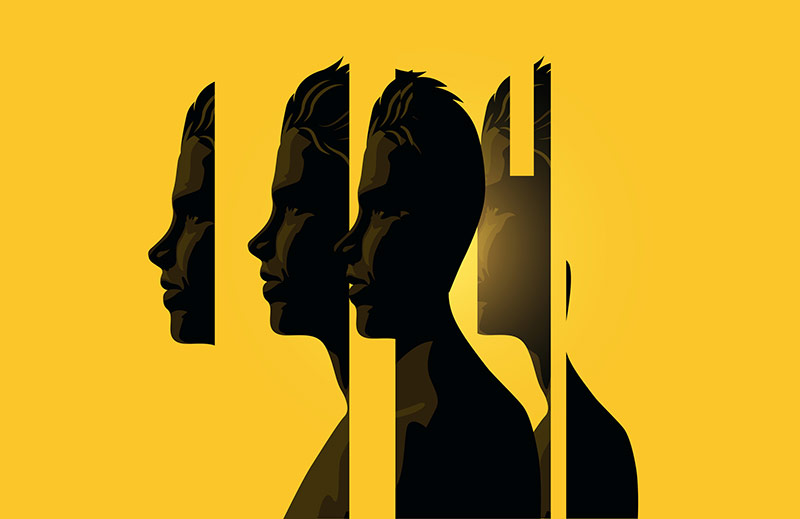“It was dark inside the wolf.” Like a chef who reinterprets a traditional dish for an expensive urban restaurant, writer Margaret Atwood proposed a reinterpretation of the story “Little Red Riding Hood” to the students of her masterclass, in line with much of contemporary popular thought: a Little Red Riding Hood that lives in the present moment.
The obsession of the current generation for living in the moment makes itself heard in the most unexpected contexts of our existence. The concept of mindfulness—that is, the state in which you reconnect with yourself, observing your feelings, physical condition, emotions and thoughts, without judging them—is seen as the main choice for combating self-alienation. In our society full of centripetal stimuli, such a vision seems a very logical remedy. However, the less popular ramifications of focusing on the present and of short-term thinking make the most interesting part of the problem remain undisputed. Living in the present will not save us, because our present is constantly losing its potentially healing properties.
What is this mindfulness?
The idea of being present in the moment is used in Buddhist teaching as a discipline of acquiring self-knowledge and wisdom for the stated purpose of enlightenment, seen as a total liberation from suffering. The main method for living in the present is meditation, and the way meditation manages to retune ourselves is to induce that state of relaxation in which we become aware of all the sensations in our body, and observe them as witnesses. Specifically, what everyone calls mindfulness today is an adaptation of Buddhist meditation in a Western context, and a version that eliminated the religious framework of the practice.
It took almost half a century for the concept of mindfulness to become a consumer product in society and, at the same time, a prosperous business. It was imported in the 1970s by the American Jon Kabat-Zinn, who in the meantime became professor emeritus of medicine and creator of the Stress Reduction Clinic and the Center for Mindfulness in Medicine, Health Care and Society, within the University of Massachusetts Medical School. Zinn too acquired it from his Buddhist mentors: Vietnamese-born peace activist Thich Nhat Hanh and Zen Master Seung Sahn, co-founder of the Cambridge Zen Center.
Far from being just a marketable promise with religious origins, mindfulness meditation has enjoyed fairly consistent scientific attention. However, over the last few decades, research that has focused on the effects of mindfulness meditation has drawn all kinds of conclusions. Some are enthusiastic about the role of meditation, others are restrained, indicating the need to dive deeper into the subject, while others warn that meditation is a waste of time because, allegedly, it has no effect on mental illness.
For example, a 2017 study that assessed the effects of meditation in the treatment of post-traumatic stress reached a reserved conclusion: “This line of research is in its relative infancy.”[1] To study the effects of meditation, researchers seek to establish a causal relationship: because they meditate, subjects improve their X, Y, Z indicators of mental well-being.
Currently, however, too few studies have been able to reach such conclusions. Still, correlative studies, which observe the association between meditation and various well-being indicators, are also relevant because they show that meditation may still have some undiscovered qualities that help people. Accordingly, another study, also from 2017, showed the existence of an association between mindfulness meditation and the reduction of stress or mood disorders.[2]
Many studies show that meditation can be used successfully in treating anxiety disorders such as panic disorder, or generalized anxiety disorder. Perhaps even more amazing are the studies that evaluate the effect of meditative thinking on reducing chronic physical pain.[3] This has led some practitioners to claim that the living-in-the-present type of meditation may even contribute to the improvement of the sex life. However, brain imaging studies that observed the influence of meditation on the brain regions responsible for perceiving physical sensations have not provided enough evidence to support such claims.[4]
In fact, the most impressive scientific results point towards the effectiveness of meditation associated with cognitive-behavioural therapy in the treatment of depression. Serious research shows that such an approach significantly reduces the risk of relapse in patients who have had three or more major depressive episodes in the past. Given the growing prevalence of depression in developed countries, we can understand why it has become so tempting today to look hopefully at mindfulness. The problem is that the popularity of mindfulness meditation has grown so much in recent years that it has far exceeded its real effectiveness, and people continue to expect more from it than it can actually offer.
Healing the past through the present
Although it is being promoted as the solution to all emotional problems, ironically, living in the moment is a post-event remedy. No one practices mindfulness in the middle of a traumatic situation. We could not imagine, for example, an Auschwitz detainee concentrating on the ethereal sensation of his emaciated body, or the cries of pain of his colleagues in the barracks, the rustling of rats, or the pitch-black that lays heavy on his eyes at night.
Moreover, concentration camp literature is full of examples of survivors who pulled through only because they were able to take refuge either in the encouraging experiences of the past or in the dreams they had of the future. In fact, often, in traumatic situations, the mind creates a barrier between us and reality, in order to prevent us from absorbing the present with every fibre of our bodies. This is what psychologists call “dissociation.”
Dissociation is a well-documented mechanism. It is an alteration of self-awareness, a detachment from reality that, in moderate cases, can be seen as a way to deal with a situation beyond our control or as a strategy to reduce and tolerate stress.[5] However, in the spectrum of dissociation, there are also pathological forms, such as depersonalization disorder, dissociative amnesia (in which a person forgets who he is and assumes a new identity), or dissociative identity disorder.
Dissociative disorders are very common among people who practice prostitution and who, in order to use their body as an object of work, need to detach from their own body, not to perceive it as part of their own identity. In fact, psychologists say that, according to existing information, almost all prostitutes suffer from at least one mental disorder, be it dissociative, post-traumatic, affective (depression, anxiety, and so on), or addiction related.[6]
Dissociation is found in people who have gone through trauma such as sexual abuse or who have been exposed to acts of violence, but it is ordinary to anyone familiar with stress. The most common form of dissociation is daydreaming. Psychologists have recently noted in their studies that daydreaming may even be beneficial for the development of creativity.[7] From philosophers, however, especially from those inclined to analyse the impact of hyper-technologisation on individuals and society, comes a more grim assessment.
The paradox of our time is that those who think they are most anchored in the present confuse their synchronization with the here and now with immersion in technology. Unfortunately, the hyper-technologisation of today’s generation is, in reality, an escape from the self, from which neither the coolest mobile applications for breathing exercises, nor the development of here-and-now thinking will be able to stop us. When we strive not to miss a single piece of what is happening, to be connected in the moment, is exactly when we are actually escaping from the present.

Dissociative association
The culprit for maximizing the priorities of the moment is, most likely, what Sci-Fi author Cory Doctorow called the “ecosystem of interruption technologies”. Doctorow was referring to computers because at the time he introduced his concept, smartphones had not yet been invented. Still, the principle applies: society has provided computers and smartphones as tools to make our lives better, easier and more pleasant. Nevertheless, the pleasure derived from the use of the two types of devices comes with a price we are only now beginning to understand, in its real magnitude.
Comedian Louis CK surprised the audience of the late-night show “Conan” when he confessed that he decided not to buy his children smartphones, explaining that he wanted to see them sad.[8] The spectators laughed, but they knew he was right. CK said that sadness comes when you are forced to be alone with your thoughts. “You need to build an ability to just be yourself and not be doing something. That’s what phones are taking away, is the ability to just sit there like this. That’s being a person, right?”
CK went on to tell how, on a long drive, his radio broadcast a song full of emotion. As the song grew in intensity, CK felt a certain melancholy creep in and begin to grow in his soul. The instinctive reaction was to get on the phone and text someone. “People are willing to risk taking a life and ruining their own, ’cause they don’t want to be alone for a second,” he said. He stopped himself. He didn’t touch the phone, and instead pulled over and allowed himself to feel his emotions.
After a healthy cry came an equally healthy portion of joy and gratitude for the life he has. He is now convinced that we need to live our feelings without stifling them with technological or other types of artifices. Because, when “you never feel completely sad or completely happy, you just feel kinda satisfied with your products. And then you die… So… that’s why I don’t want to give a phone to my kids.”
Under the addictive force of the tools we have built to help us ground ourselves better and not miss anything, we have come to believe that everything that happens around us is equally important and unmissable. But when everything is equally important, in reality, nothing matters anymore.
The real connection
Artificial stimuli, which divert our attention towards thousands of subjects seemingly worthy of our emotional involvement, deprive us of more than the ability to fully feel emotions. Linda Stone, a researcher at Microsoft, considers our present a frame of mind of “continuous partial attention,” that is, the state in which we are permanently connected to a flow of information or stimuli that demand our attention, but not at full capacity.
In fact, even as we strive to savour the present, most of us suffer from “temporal exhaustion”. As sociologist Elise Boulding said (in 1978!), “if one is mentally out of breath all the time from dealing with the present, there is no energy left for imagining the future.” This, too, is a form of self-alienation.
The philosopher Matthew Crawford, a researcher at the Institute for Advanced Studies in Culture of the University of Virginia, argued in his book, The World Beyond Your Head, that our failure to focus not only threatens our individuality and freedom but also the fact that this failure has moral weight.[9] Crawford believes that the “fun” that characterizes the connected generation reduces individuals to an amorphous mass.
What is more, this is only one of the “problems that arise as a result of a loss of connection to material reality, the world of flesh, blood, wire, and mud”, as journalist Brian Dijkema summed up in a review of the book.
Dijkema’s expression seems a close relative of the terminology used by the Catholic priest Ivan Illich in an essay in which he lamented the degradation of people’s communion with God as a result of their alienation from Nature. Illich wrote, even before the Internet became as ubiquitous as it is today, that “…the novice to the sacred liturgy and to mental prayer has a historically new task. He is largely removed from those things—water, sunlight, soil, and weather—that were made to speak of God’s presence. In comparison with the saints whom he tries to emulate, his search for God’s presence is of a new kind. Today’s convert must recognize how his senses are continuously shaped by the artefacts he uses. They are charged by design with intentional symbolic loads, something previously unknown.”[10]
We return to Crawford because one of his findings about today’s culture perfectly complements what Illich said. Crawford argues that understanding human rationality as a deep suspicion of knowledge gained through direct interaction with the objects in the world has produced a philosophical revolution with prominent signatories such as Descartes, Locke, and Kant. In this revolution, “the standard for truth is relocated: it is no longer found out in the world, but inside our own head… Attention is therefore demoted. Or rather, it is redirected. Not by fastening on objects in the world does it help us grasp reality, but by being directed to our own processes of thinking, and making them the object of scrutiny.”[11]
We thus come to a key question: What can we really know about the world and what can we really know about God, when our main form of empirical verification targets only the optimal functioning of our mind? What can we really know about ourselves when we live strictly in the present?
The answer could come from Professor Bobby Duffy, director of the Policy Institute at King’s College London, author of the book The Perils of Perception. Duffy, who up until recently was the managing director of the Social Research Institute at Ipsos MORI, asserts the existence of a significant gap between people’s perceptions and reality. “Across all the studies and in every country, people get a lot wrong on nearly every topic we’ve covered, including immigration levels, teen pregnancy, crime rates, obesity, trends in global poverty, and how many people are on Facebook.”[12]
Using our logic, we can extract from this the fact that it is not enough to use logic or to relate to what we find plausible, when we can verify our ideas with the factual information available to us. The risk that arises when we spend too much time in our own minds is to cultivate our deeply human tendency to pay unwarranted attention to preconceptions.
“We are generally wired to focus on the negative,” Duffy said. “Negative information is attention-grabbing—it is literally processed differently in our brains,” takes up more space, ignites us more emotionally, and so it stays with us for longer. That’s why, as he pointed out in an interview with PressOne, one of the key conclusions in the book is that how our brains work is not the only thing that matters.[13]
In reality, we cannot understand how our brains work without understanding how the world works, because our reason is not a self-set machine. Admitting this alludes to the rhetorical nature of the second question. We are never so alone as to say that we have known God only with our minds. Where does our data about God come from? Nature, providence, and Scripture—especially Scripture.
The challenge greater than living in the present
The present, in itself, does not cure anything. But it can be a healing tool if our attitude towards it is healthy. Health comes from the balance that rejects the hedonism and egocentrism that characterizes the popular ways of living in the moment. It comes from the balance that also rejects the loss of the self by dissolving in the environment (be it social or technological). We need to be among people, and we need to be alone as well. If we focus only on one of them, things won’t work out for us.
The technological world that we have modelled according to our taste brings us the social up until we reach the land of Nod. We even take our phones into the restroom! So, in a very practical sense, we are never alone. But this illusion of device-mediated socialization is a simulacrum that keeps us stuck between two worlds: that of beneficial aloneness, which we think we can live at any time (just try to leave the phone aside for only one day), and that of beneficial socialization, which we are under the impression that we can live with the help of communication technology (how much warmth does the hug of a smartphone give?).
The same surrogates can intervene in our communion with God. We can spend many hours in church without meeting Him there. We can read entire libraries about Him, without a real exchange between Him and us.
It is already obvious that the remedy will not come from our escape into our deepest feelings. This escape can isolate us from others and God, just like our immersion in technological distractions does. We need to know ourselves, but there is an even greater need not to remain in a loop of self-examination that will take us away from people and keep God at bay. Relationships can bring us spiritual fulfilment like no intellectual satisfaction can. But for this, we need to get out of ourselves, give up our subterfuges (phones) and, more than to live in the present, to get out of its traps and live meaningfully. This the bigger, but more worthwhile, challenge.



















